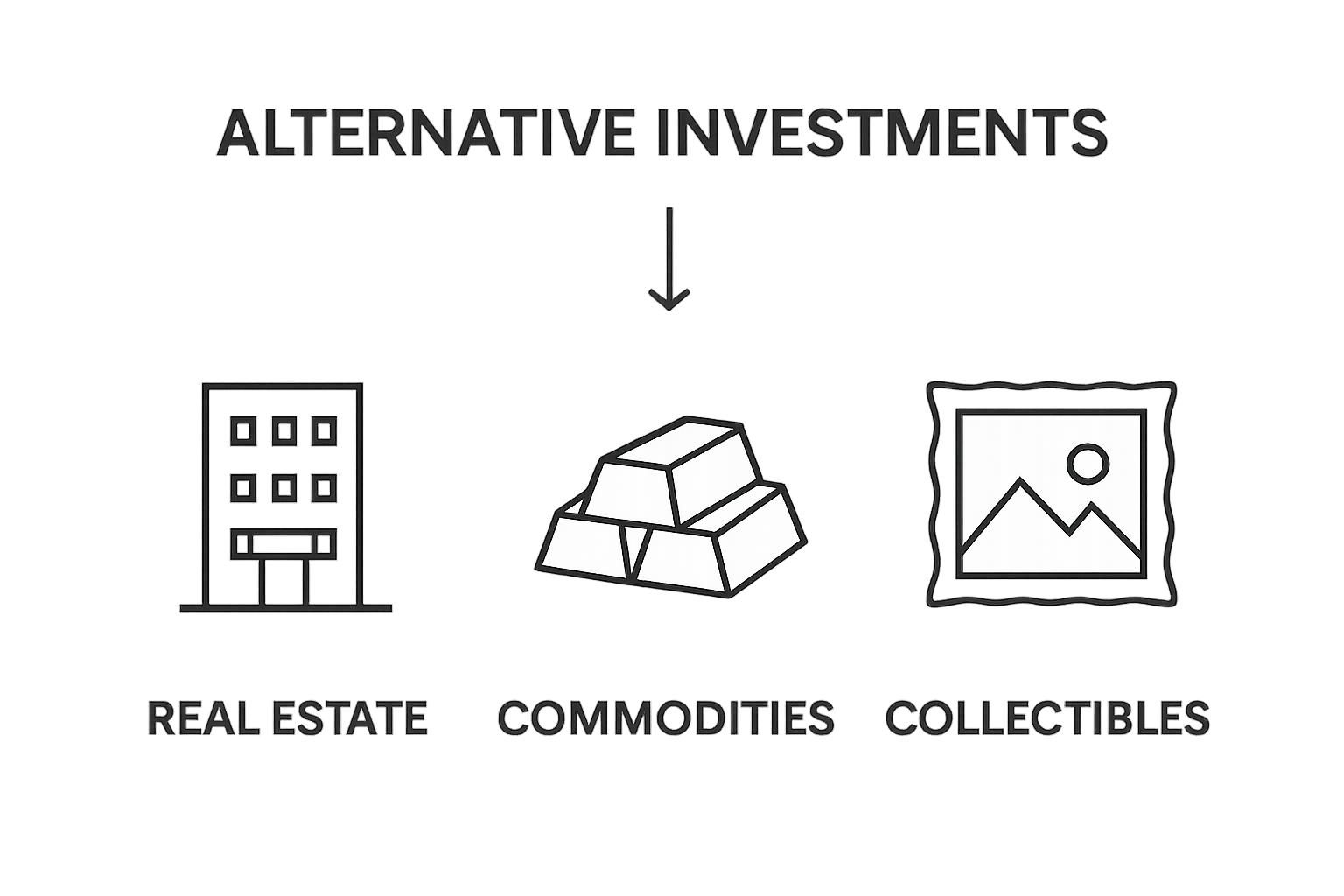Everyone talks about stocks and bonds when it comes to investing and building wealth. Yet more and more investors are looking beyond the usual picks. It turns out, some high-net-worth individuals now put over half their portfolios into alternative investments. That is not just surprising, it flips the script on what most people think is smart investing.
Table of Contents
- Defining Alternative Investments: What They Are
- The Importance Of Alternative Investments In Portfolios
- How Alternative Investments Work In Practice
- Key Concepts In Alternative Investments And Their Implications
- Evaluating Risks And Benefits Of Alternative Investments
Quick Summary
| Takeaway | Explanation |
|---|---|
| Alternative investments diversify portfolios. | Incorporating alternative assets can reduce overall investment risk and volatility, enhancing portfolio stability. |
| Higher returns are possible with alternatives. | Many alternative investments offer the potential for significant financial gains, often outperforming traditional assets. |
| Investors need specialized knowledge. | Understanding complex investment structures and market dynamics is crucial for effectively navigating alternative investments. |
| Liquidity and valuation are challenging. | Alternative investments can be difficult to sell quickly and may pose unique valuation issues compared to conventional assets. |
| Strategic risk management is essential. | A comprehensive approach to risk assessment is required to balance the unique risks associated with alternative investments. |
Defining Alternative Investments: What They Are
Alternative investments represent a sophisticated financial category that extends far beyond traditional investment vehicles like stocks and bonds. These unique assets offer investors opportunities to diversify portfolios, potentially mitigate risk, and generate returns through unconventional financial instruments.
Understanding the Core Definition
At their fundamental level, alternative investments are financial assets that do not conform to standard investment classifications. Unlike publicly traded stocks or government bonds, alternative investments encompass a wide range of assets that operate outside conventional financial markets.
 According to Investopedia, these investments include:
According to Investopedia, these investments include:
- Private equity
- Real estate
- Hedge funds
- Commodities
- Art and collectibles
- Cryptocurrency
- Venture capital investments
What distinguishes alternative investments is their potential to provide portfolio diversification and potentially higher returns compared to traditional investment strategies. Sophisticated investors often use these assets to reduce overall portfolio volatility and create more balanced investment approaches.
Characteristics of Alternative Investments
Alternative investments share several unique characteristics that set them apart from traditional investment options. They typically feature:
- Lower correlation with standard market indices: This means their performance does not necessarily move in sync with stock or bond markets
- Potentially higher returns: Many alternative investments offer opportunities for significant financial gains
- Limited liquidity: These assets are often harder to buy and sell quickly compared to publicly traded securities
- Higher minimum investment requirements: Many alternative investments demand substantial initial capital commitment
By understanding these nuanced financial instruments, investors can strategically incorporate alternative investments into their wealth management strategies, potentially enhancing overall portfolio performance and risk management.
Below is a feature table that summarizes the unique characteristics of alternative investments compared to traditional investments, to help readers quickly distinguish between these two asset categories.
| Feature | Alternative Investments | Traditional Investments |
|---|---|---|
| Correlation with Market Indices | Typically low | Usually high |
| Potential Returns | Potentially higher | Generally moderate |
| Liquidity | Limited; harder to buy or sell quickly | High; easy to trade |
| Minimum Investment Requirements | Often higher | Usually lower |
| Access and Transparency | More restricted, less transparency | Widely accessible, high transparency |
| Common Examples | Private equity, real estate, hedge funds | Stocks, bonds |
The Importance of Alternative Investments in Portfolios
Portfolio construction is an intricate art of balancing risk and potential returns, and alternative investments play a crucial role in achieving sophisticated investment strategies. By introducing assets that behave differently from traditional financial instruments, investors can create more resilient and dynamic investment portfolios.
Diversification and Risk Management
Diversification remains the cornerstone of intelligent investment strategy. Research from McKinsey & Company demonstrates that portfolios incorporating alternative investments can significantly reduce overall investment risk. Alternative assets provide critical portfolio protection by:
- Reducing overall portfolio volatility
- Offering returns uncorrelated with traditional market movements
- Providing insulation during economic downturns
- Creating opportunities for non-traditional wealth generation
Traditional investment approaches often leave portfolios vulnerable to market fluctuations. Alternative investments introduce financial instruments that can perform independently of stock and bond markets, creating a more robust investment ecosystem.
Performance Enhancement Potential
Beyond risk management, alternative investments offer compelling performance enhancement opportunities. Sophisticated investors recognize these assets can generate superior returns compared to conventional investment vehicles. High-net-worth individuals and family offices frequently allocate significant portfolio percentages to alternative investments to optimize financial outcomes.
Key performance advantages include potential for:
- Higher returns compared to traditional asset classes
- Access to unique market opportunities
- Potential for asymmetric return profiles
- Enhanced long-term wealth accumulation strategies
By strategically integrating alternative investments, investors can create more nuanced, adaptable portfolios capable of navigating complex financial landscapes. The goal is not replacement of traditional investments but intelligent complementation to achieve more sophisticated financial objectives.
How Alternative Investments Work in Practice
Alternative investments operate through complex mechanisms that differ significantly from traditional investment approaches. Understanding their practical implementation requires examining the unique structures, investment strategies, and operational frameworks that distinguish these financial instruments.
Investment Structures and Access Mechanisms
According to the CFA Institute, alternative investments typically involve sophisticated investment structures that require specialized knowledge and access. Investors can engage with these assets through multiple approaches:
- Direct investment: Purchasing specific assets like real estate or art pieces
- Fund investing: Participating in pooled investment vehicles managed by professional managers
- Co-investing: Collaborating with other investors or investment firms
- Indirect participation: Investing through specialized financial intermediaries
These structures enable investors to navigate less efficient markets and access opportunities not available through traditional investment channels. Professional managers often utilize complex compensation models designed to align investor and manager interests over extended investment periods.
Risk Management and Performance Evaluation
Practical implementation of alternative investments demands rigorous risk assessment and performance monitoring. Sophisticated investors employ advanced analytical techniques to evaluate these unique assets, considering factors beyond standard market metrics.
Key evaluation considerations include:
- Assessing liquidity constraints
- Understanding asymmetric return profiles
- Analyzing correlation with broader market movements
- Evaluating manager expertise and track record
Successful alternative investment strategies require continuous monitoring, flexible investment approaches, and a deep understanding of specialized market dynamics. By embracing these nuanced investment mechanisms, investors can unlock potential value and create more resilient, diversified portfolios.
Key Concepts in Alternative Investments and Their Implications
Alternative investments represent a complex ecosystem of financial strategies that extend far beyond traditional investment paradigms. Understanding their fundamental concepts requires deep insight into the sophisticated mechanisms that drive these unique assets.
Structural Complexity and Market Dynamics
According to the Chartered Alternative Investment Analyst (CAIA) Association, alternative investments are characterized by intricate structural frameworks that distinguish them from conventional financial instruments. These investments operate through nuanced market dynamics that demand specialized knowledge and analytical approaches.
Key structural characteristics include:
- Non-traditional asset allocation: Moving beyond standard stocks and bonds
- Complex compensation structures: Performance-based fee arrangements
- Limited transparency: Less regulated and publicly disclosed information
- Higher minimum investment thresholds: Restricting access to sophisticated investors
The complexity of these investments creates both opportunities and challenges for investors seeking to diversify their portfolios and generate unique returns.
Risk and Performance Considerations
Alternative investments introduce distinctive risk profiles that require advanced understanding and strategic management. Sophisticated investors recognize that these assets demand a more holistic approach to financial analysis.
Critical performance considerations encompass:
- Asymmetric return potential
- Higher volatility compared to traditional investments
- Longer investment horizons
- Unique correlation patterns with broader market movements
Successful navigation of alternative investments requires a sophisticated understanding of these nuanced financial instruments. Investors must develop comprehensive strategies that account for the unique characteristics and potential value propositions embedded within these complex asset classes.

Evaluating Risks and Benefits of Alternative Investments
Navigating the complex landscape of alternative investments requires a strategic approach to understanding both potential rewards and inherent risks. Sophisticated investors must develop comprehensive frameworks for evaluating these nuanced financial instruments beyond traditional investment analysis methods.
Risk Assessment Frameworks
Research from the Harvard Business Review highlights the critical importance of developing sophisticated risk evaluation techniques for alternative investments. Comprehensive risk assessment involves examining multiple dimensions beyond standard financial metrics.
Key risk evaluation considerations include:
- Liquidity risk: Potential challenges in converting assets to cash
- Valuation complexity: Difficulty in accurately determining asset value
- Regulatory uncertainty: Potential changes in legal and compliance frameworks
- Counterparty risk: Potential default or performance issues from investment partners
Understanding these risk factors requires a multilayered approach that goes beyond traditional financial analysis. Sophisticated investors recognize that alternative investments demand more nuanced risk management strategies.
Potential Benefits and Strategic Advantages
Despite their complex risk profile, alternative investments offer compelling strategic advantages for forward-thinking investors. These assets provide unique opportunities for portfolio diversification and potential performance enhancement.
Primary strategic benefits encompass:
- Portfolio diversification beyond traditional asset classes
- Potential for higher returns compared to conventional investments
- Reduced correlation with standard market movements
- Access to unique investment opportunities not available in public markets
Successful alternative investment strategies require a balanced approach that carefully weighs potential risks against anticipated benefits. Investors must develop sophisticated analytical frameworks that account for the unique characteristics of these complex financial instruments.
The table below organizes key risks and strategic benefits of alternative investments to enable quick comparison for investors weighing their options.
| Category | Key Risks | Strategic Benefits |
|---|---|---|
| Liquidity | Difficult to quickly convert to cash | Not subject to forced sale in volatile markets |
| Valuation | Complex and sometimes subjective asset evaluation | Unique opportunities not found in public markets |
| Regulation | Uncertain or changing regulatory environments | Reduced correlation with standard assets |
| Counterparty | Partner or manager could default | Potential for higher returns |
Elevate Your Alternative Investment Strategy With Community Insight
Are you struggling to navigate the complexities of alternative investments and seeking reliable expert insights to manage portfolio risk and maximize returns? The article highlights how essential it is to understand non-traditional asset classes, unique risk profiles, and advanced wealth strategies especially for family offices and ultra-high-net-worth investors. Yet, connecting with trustworthy resources and peers often feels challenging and isolating.

Do not leave your investment decisions to guesswork. Join the Future Family Office platform to access a robust global network designed for sophisticated investors. The site offers you immediate access to family office directories, service providers, and ongoing news tailored to alternative investments and private wealth management. Create your profile today and connect with knowledgeable peers, stay informed with expert investment articles, and unlock resources that move you ahead. The right connections and insights are just a click away—explore Future Family Office and secure your advantage now.
Frequently Asked Questions
What are alternative investments?
Alternative investments are financial assets that do not fit traditional investment categories, including options like private equity, real estate, hedge funds, commodities, art and collectibles, cryptocurrency, and venture capital.
Why are alternative investments important for a portfolio?
Alternative investments help diversify portfolios, reduce overall risk, and provide potential returns uncorrelated with traditional market movements, making them crucial for resilient investment strategies.
What are the key characteristics of alternative investments?
Key characteristics of alternative investments include lower correlation with standard market indices, potentially higher returns, limited liquidity, and often higher minimum investment requirements compared to traditional investments.
How do alternative investments manage risk?
Alternative investments manage risk by employing rigorous assessment techniques, analyzing factors like liquidity constraints, asymmetric return profiles, and the expertise of fund managers to monitor and evaluate performance continuously.
Recommended
- Turning private equity into a liquid vehicle: “The overarching challenge is maintaining liquidity in the fund” – Future Family Office
- What Investor Biases Are Open Investors Most Prone To? – Future Family Office
- When Cash Is Not King: The New Favorite Investment Options For Family Offices – Future Family Office
- 5 Family Offices Making Impact Investments – Future Family Office




